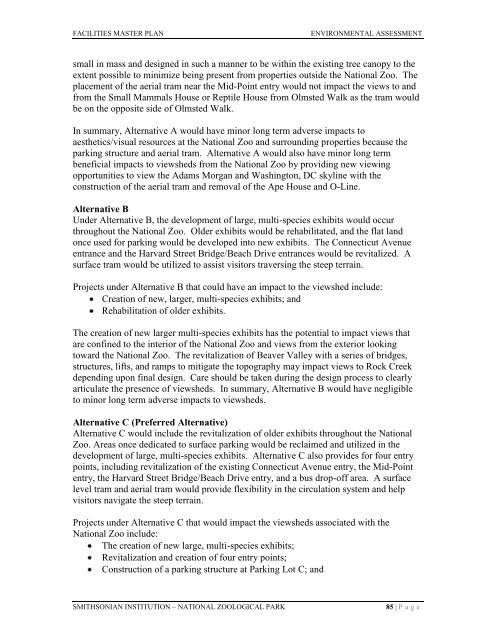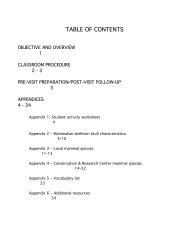facilities renewal master plan - National Zoo - Smithsonian Institution
facilities renewal master plan - National Zoo - Smithsonian Institution
facilities renewal master plan - National Zoo - Smithsonian Institution
You also want an ePaper? Increase the reach of your titles
YUMPU automatically turns print PDFs into web optimized ePapers that Google loves.
FACILITIES MASTER PLAN ENVIRONMENTAL ASSESSMENT<br />
small in mass and designed in such a manner to be within the existing tree canopy to the<br />
extent possible to minimize being present from properties outside the <strong>National</strong> <strong>Zoo</strong>. The<br />
placement of the aerial tram near the Mid-Point entry would not impact the views to and<br />
from the Small Mammals House or Reptile House from Olmsted Walk as the tram would<br />
be on the opposite side of Olmsted Walk.<br />
In summary, Alternative A would have minor long term adverse impacts to<br />
aesthetics/visual resources at the <strong>National</strong> <strong>Zoo</strong> and surrounding properties because the<br />
parking structure and aerial tram. Alternative A would also have minor long term<br />
beneficial impacts to viewsheds from the <strong>National</strong> <strong>Zoo</strong> by providing new viewing<br />
opportunities to view the Adams Morgan and Washington, DC skyline with the<br />
construction of the aerial tram and removal of the Ape House and O-Line.<br />
Alternative B<br />
Under Alternative B, the development of large, multi-species exhibits would occur<br />
throughout the <strong>National</strong> <strong>Zoo</strong>. Older exhibits would be rehabilitated, and the flat land<br />
once used for parking would be developed into new exhibits. The Connecticut Avenue<br />
entrance and the Harvard Street Bridge/Beach Drive entrances would be revitalized. A<br />
surface tram would be utilized to assist visitors traversing the steep terrain.<br />
Projects under Alternative B that could have an impact to the viewshed include:<br />
Creation of new, larger, multi-species exhibits; and<br />
Rehabilitation of older exhibits.<br />
The creation of new larger multi-species exhibits has the potential to impact views that<br />
are confined to the interior of the <strong>National</strong> <strong>Zoo</strong> and views from the exterior looking<br />
toward the <strong>National</strong> <strong>Zoo</strong>. The revitalization of Beaver Valley with a series of bridges,<br />
structures, lifts, and ramps to mitigate the topography may impact views to Rock Creek<br />
depending upon final design. Care should be taken during the design process to clearly<br />
articulate the presence of viewsheds. In summary, Alternative B would have negligible<br />
to minor long term adverse impacts to viewsheds.<br />
Alternative C (Preferred Alternative)<br />
Alternative C would include the revitalization of older exhibits throughout the <strong>National</strong><br />
<strong>Zoo</strong>. Areas once dedicated to surface parking would be reclaimed and utilized in the<br />
development of large, multi-species exhibits. Alternative C also provides for four entry<br />
points, including revitalization of the existing Connecticut Avenue entry, the Mid-Point<br />
entry, the Harvard Street Bridge/Beach Drive entry, and a bus drop-off area. A surface<br />
level tram and aerial tram would provide flexibility in the circulation system and help<br />
visitors navigate the steep terrain.<br />
Projects under Alternative C that would impact the viewsheds associated with the<br />
<strong>National</strong> <strong>Zoo</strong> include:<br />
The creation of new large, multi-species exhibits;<br />
Revitalization and creation of four entry points;<br />
Construction of a parking structure at Parking Lot C; and<br />
SMITHSONIAN INSTITUTION – NATIONAL ZOOLOGICAL PARK 85 | P a g e

















